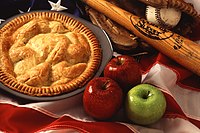Cultural icon

A cultural icon is an artifact that is recognised by members of a culture or sub-culture as representing some aspect of cultural identity. Cultural icons vary widely, and may be visual, audio, an object, a person or group of people, etc.
In the media, many items of popular culture have been called "iconic" despite their lack of durability. Some commentators believe that the word is overused or misused.[1]
Types

A subset of cultural icons are national icons.
A web-based survey was set up in 2006 allowing the public to nominate their ideas for national icons of England[2] and the results reflect the range of different types of icon associated with an English view of English culture. Some examples are:
- Big Ben (the nickname for the bell, but widely recognised as Elizabeth Tower of the Houses of Parliament in London);[3][4][5]
- Cup of tea (for the British tea drinking habit);[3][6][7]
- Red telephone box;[8][9][10]
- Red Routemaster London double decker bus;[3][8][9]
- Spitfire, a World War II fighter aircraft.[3][9][11]
Matryoshka dolls are seen internationally as cultural icons of Russia.[12]

The values, norms and ideals represented by a cultural icon vary both among people who subscribe to it, and more widely among other people who may interpret cultural icons as symbolising quite different values. Thus an apple pie is a cultural icon of the United States, but its significance varies among Americans.
National icons can become targets for those opposing or criticising a regime, for example, crowds destroying statues of Lenin in Eastern Europe after the fall of communism[14] or burning the Stars and Stripes flag to protest about US actions abroad.[15]
Religious icons can also become cultural icons in societies where religion and culture are deeply entwined, such as representations of the Madonna in societies with a strong catholic tradition.[16]
Use in popular media
Describing something as iconic or as an icon has become very common in the popular media. This has drawn criticism from some: a writer in Liverpool Daily Post calls "iconic" "a word that makes my flesh creep," a word "pressed into service to describe almost anything."[17] The Christian Examiner nominates "iconic" in its list of overused words, finding over 18,000 "iconic" references in news stories alone, with another 30,000 for "icon", including its use for SpongeBob SquarePants.[18]
See also
References
- ^ Heard about the famous icon? We have - far too often, The Independent (London), January 27, 2007
- ^ "Our Collection". icons.org.uk. Retrieved August 16, 2014.
- ^ a b c d British Postal Museum & Archive: Icons of England. Retrieved 15 December 2012.
- ^ Holloway, J Christopher; Taylor, Neil (7th Edition, 2006 (First published 1983)). The Business of Tourism. Pearson Education. p. 217.
{{cite book}}: Check date values in:|year=(help)CS1 maint: multiple names: authors list (link) CS1 maint: year (link) - ^ McManus, Erwin Raphael (2001). An Unstoppable Force: Daring to Become the Church God Had in Mind. Flagship Church Resources. p. 113.
- ^ BBC: Tea steams ahead in icon hunt. Retrieved 15 December 2012.
- ^ Thorne, Tony (2011). The 100 Words that Make the English. Hachette Digital (e-book).
{{cite book}}:|work=ignored (help) - ^ a b Jenkins, Simon; Dean Godson (editor) (October 2005). "Replacing the Routemaster" (PDF). p. 7. Retrieved December 15, 2012.
{{cite web}}:|author=has generic name (help)CS1 maint: multiple names: authors list (link) - ^ a b c Culture24: Icons of England. Retrieved 15 December 2012.
- ^ O'Neill, Brendan (2 April 2009). "Gulf News / Christian Science Monitor". To save a past that rings a bell. Retrieved December 15, 2012.
- ^ Parker, Mike (2012). Cultural Icons: A Case Study Analysis of their Formation and Reception (PhD Thesis). University of Central Lancashire. pp. 123–167.
{{cite book}}:|work=ignored (help) - ^ Bobo, Suzanna (25 December 2012). "Scuttlebutt: Wooden toy tells a story of love and industry". Kodiak Daily Mirror. Retrieved 9 April 2013.
- ^ "Review: Madonna Style". M. November 12, 2012. Retrieved April 16, 2013.
- ^ Jones, Jonathan (December 9, 2013). "Why smashing statues can be the sweetest revenge". Guardian.
- ^ Laessing, ulf (September 14, 2012). "Anti-American fury sweeps Middle East over film". Reuters.
- ^ Creating Ourselves, African Americans and Hispanic Americans on popular culture and religious expression. Duke University Press. 2009.
{{cite book}}: Unknown parameter|editors=ignored (|editor=suggested) (help) - ^ Let's hear it for the Queen's English, Liverpool Daily Post
- ^ Modern word usage amazingly leaves us yearning for gay, old times, Christian Examiner
Bibliography
- Biedermann, Hans (1994). Dictionary of Symbolism: Cultural Icons and the Meanings Behind Them. Meridan.
- Brooker, Will (2001). Batman Unmasked: Analysing a Cultural Icon. Continuum.
- Edwards, Peter; Karl Enenkel, and Elspeth Graham (editors) (2011). The Horse as Cultural Icon: The Real and the Symbolic Horse in the Early Modern World. Brill.
{{cite book}}:|author=has generic name (help)CS1 maint: multiple names: authors list (link) - Foudy, Julie; Leslie Heywood and Shari L Dworkin (2003). Built to Win: The Female Athlete as Cultural Icon. University of Minnesota Press.
{{cite book}}: CS1 maint: multiple names: authors list (link) - Gilbert, Erik (2008). The Dhow as Cultural Icon. Boston University.* Heyer, Paul (2012). Titanic Century: Media, Myth, and the Making of a Cultural Icon. Praeger.
- Heyer, Paul (2012). Titanic Century: Media, Myth, and the Making of a Cultural Icon. Praeger.
- Meyer, Denis C. (2010). Cles Pour la France en 80 Icones Culturelles. Hachette.
- Nelkin, Dorothy and M Susan Lindee (2004). The DNA Mystique: The Gene as a Cultural Icon. University of Michigan Press.
- Reydams-Schils, Gretchen J (2003). Plato's Timaeus as Cultural Icon. University of Notre Dame Press.
